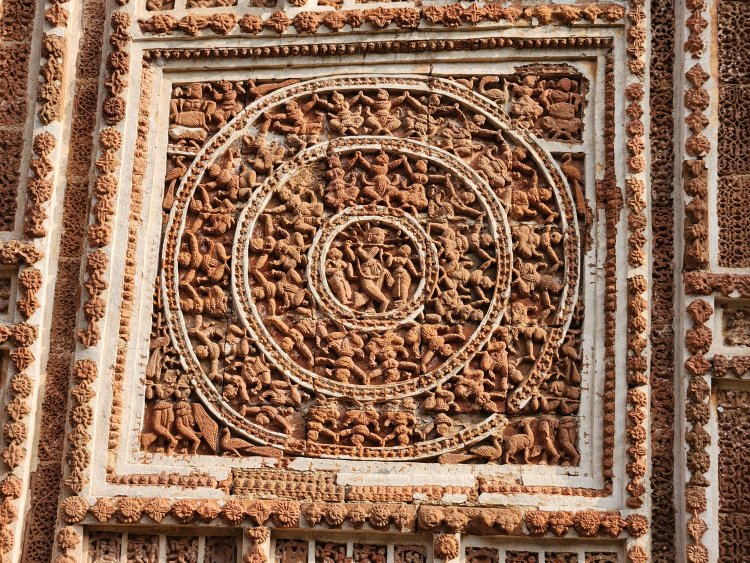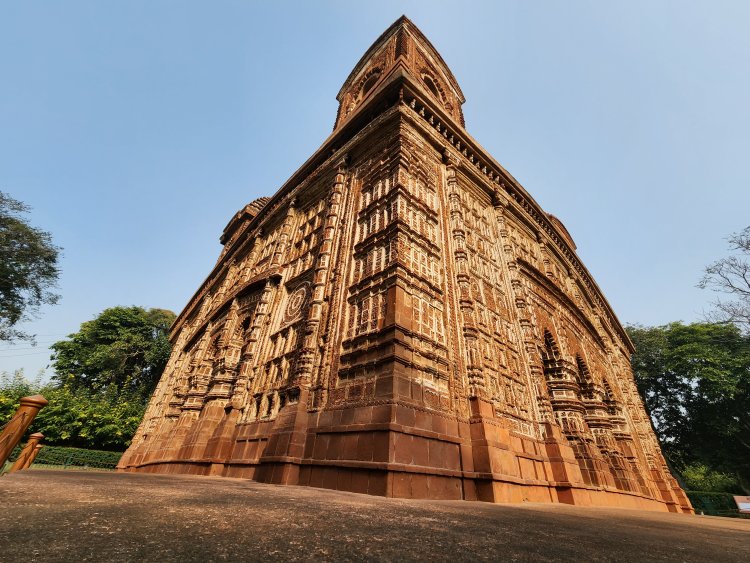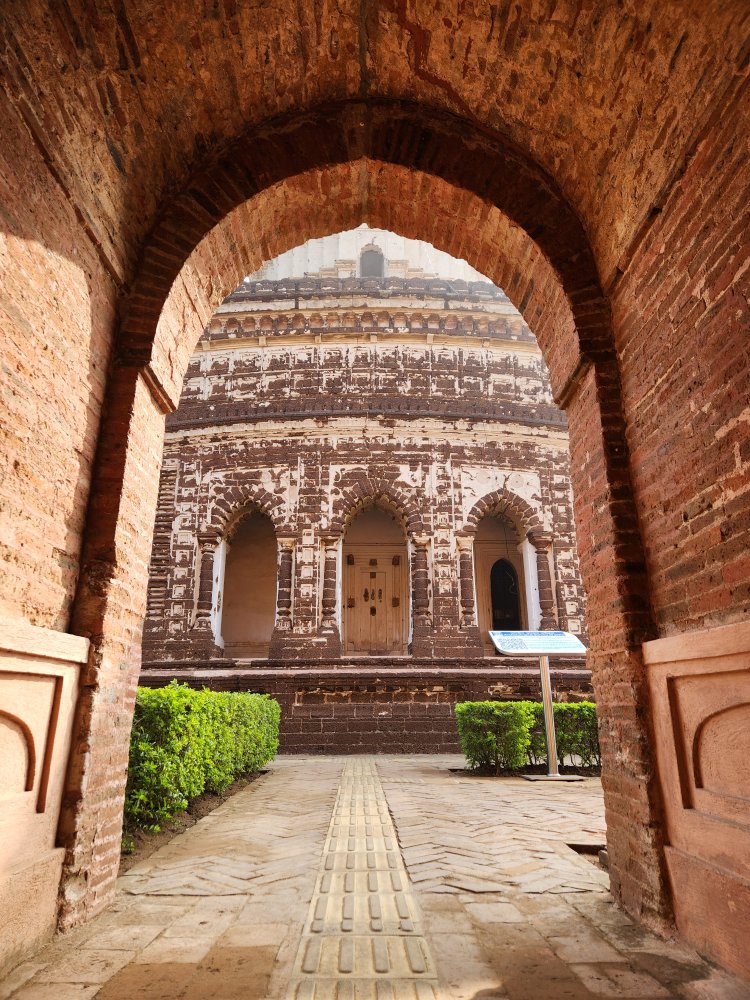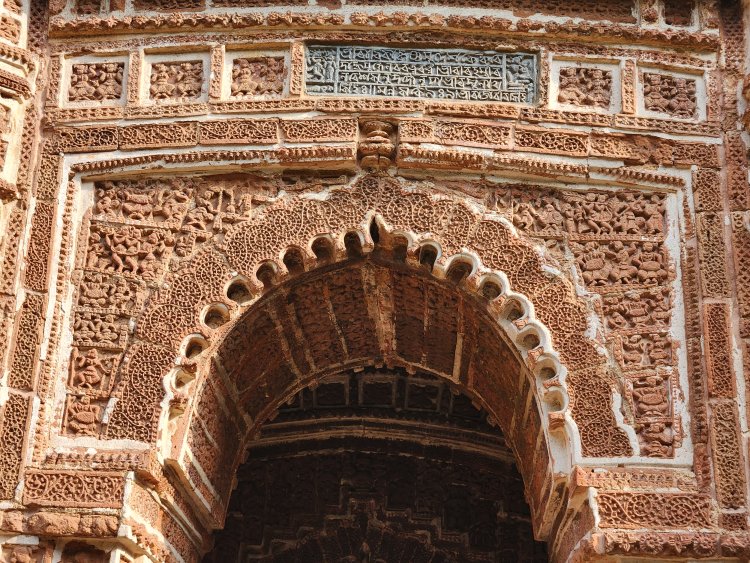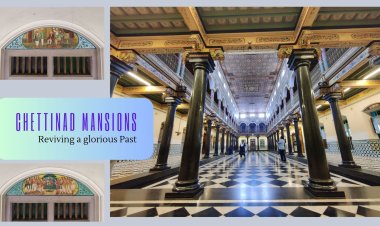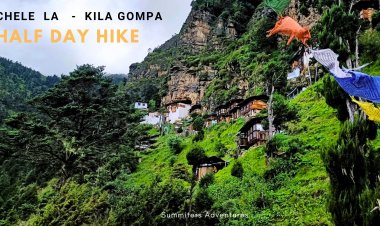Around Bishnupur
Most of Bishnupur Temples can be covered on Foot in 2 circuits except Madanmohan Temple which is a little off the walking route. The soil here is red and stone,The temples are visible from a distance made of this earth as a combination of laterite and terracotta, while some still reflect the bright color while others have a layer of black on them due to years of erosion and neglect.
The main attraction are the temples which can be covered in 2 circuits and takes about 2 hours
Circuit A will take about 2 hours duration
Circuit B will take about 3 hours .The temples in Circuit B still have intricate artwork on the walls and pillars are atluring and that is worth the time.
As I was passing through the alleys I listened to a baul sitting by the roadside and singing a catchy, reverberating in my ears, a colloquial song in praise of Krishna and Radharani while strumming at his “Ektara” - A stringed musical instrument.
Mrinmayee Temple –
Mrinmoyee temple, the oldest temple of Bishnupur was established by King Jagat Malla in 997 AD. According to local history, Maa Mrinmoyee ordered the king in his dreams to build the temple. Goddess Durga is worshipped here as Maa Mrinmoyee. Although the temple had to be reconstructed, the idol made of Ganga clay remained same.
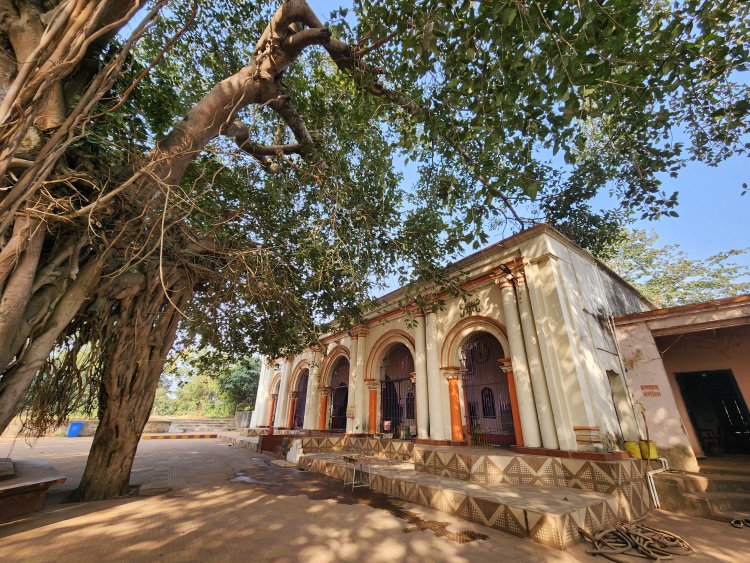 Experience the oldest Durga Puja of Bengal (1021 years) and rich heritage immersing into a different flavor of religious warmth during the Puja. The festival starts with the worship of “Baro thakurani”, “Mejo thakurani” and “Choto thakurani” respectively, after setting up of a clay pot or “Ghat”. On the sacred moment of “Mahastami- Sandhipuja”, a cannon is fired and then vegetables are sacrificed.
Experience the oldest Durga Puja of Bengal (1021 years) and rich heritage immersing into a different flavor of religious warmth during the Puja. The festival starts with the worship of “Baro thakurani”, “Mejo thakurani” and “Choto thakurani” respectively, after setting up of a clay pot or “Ghat”. On the sacred moment of “Mahastami- Sandhipuja”, a cannon is fired and then vegetables are sacrificed.
Rasamancha
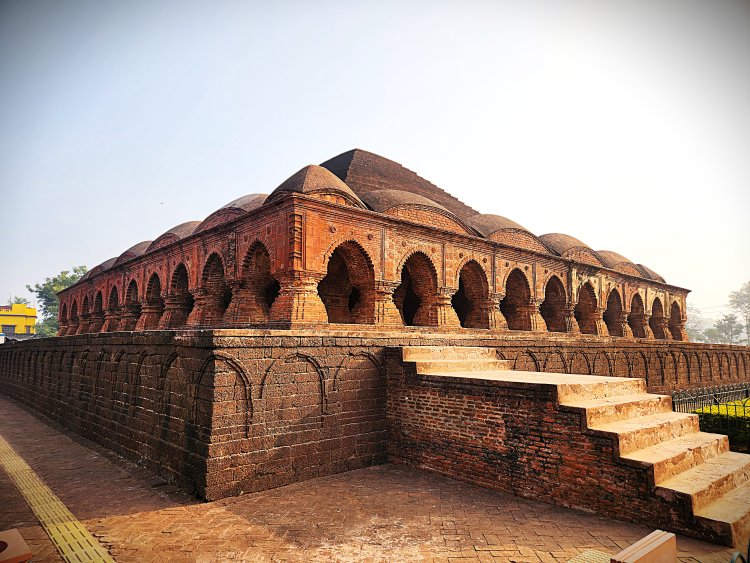 Constructed over four hundred years ago, between the 17th and 18th century, these temples display diverse styles of unique architecture. Rasmancha, for example, made in the year 1600 AD by king Bir Hambir for the annual ‘ras' festival, looks more like a baradari (pavilion) and less like a temple. The building stands on a high raised platform and is held together in an intricate pattern of thin bricks with indigenous mortar made of lentils, spices, milk, rice husk, etc.
Constructed over four hundred years ago, between the 17th and 18th century, these temples display diverse styles of unique architecture. Rasmancha, for example, made in the year 1600 AD by king Bir Hambir for the annual ‘ras' festival, looks more like a baradari (pavilion) and less like a temple. The building stands on a high raised platform and is held together in an intricate pattern of thin bricks with indigenous mortar made of lentils, spices, milk, rice husk, etc.
Low-arched corridors run throughout across its length and breadth, surrounding the dark pyramidal sanctum while the dark garbhagriha ( sanctum ) is devoid of any ornamentation or deities.
Note - Visitors can get the entry tickets for all the Bishnupur temples from Rasmancha
Jor Bangla Temple - Kesta Rai Temple
Also called Yorubangala, the Jor Bangla Temple in Bishnupur was built by King Raghunath Singha Dev II in the year 1655 CE. It is one of the masterpieces of terracotta architecture and only few temples of Bishnupur which is in good condition. It is richly ornamented with terracotta carvings.
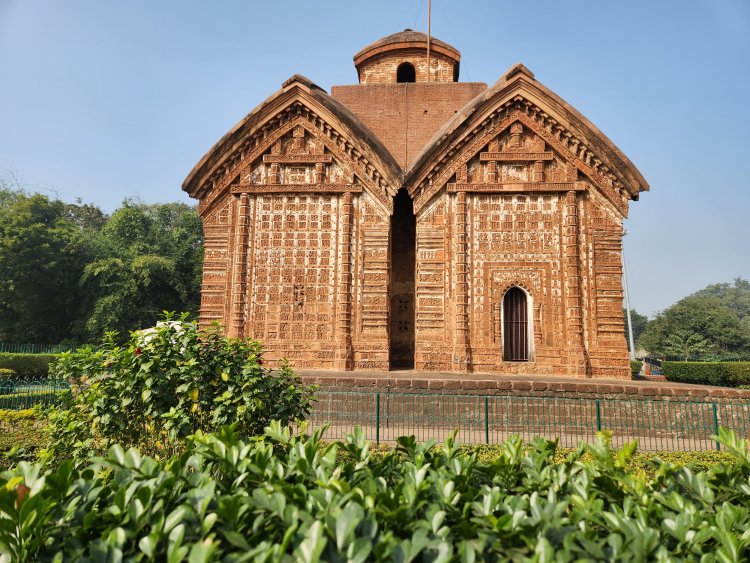
The temple is known for its classic chala style of Bengal architecture. Made of laterite bricks, the temple has an appearance of two thatched huts joined together and surmounted by a single tower. One of the two huts serves as a porch, while the inner hut functions as the shrine. There is the idol of Shadbhuja (6 hands) Lord Gaurasundara, symbolizing his six arms. of Shri Chaitanya in the prayer room which is not worshiped anymore.

The Jor Bangla Temple is famed for its opulent terracotta structure and delicate carvings on the walls. The carvings on the walls depict episodes from the Ramayana, Mahabharata and other prominent holy Hindu scriptures. One can also see other paintings and sculptures include royal hunting sights, musicians and dancers.
Lord Krishna playing his flute for Radha to scenes of everyday life, including farmers, musicians, and dancers.A closer look at the terracotta panels one can spot lesser-known stories from Indian mythology, such as Krishna lifting Govardhan Hill. The detailing in the carvings reflects the artistic excellence of Bishnupur’s craftsmen even today.
Lalji Temple
Situated near Jor Bangla Temple, it is one of the prominent terracotta temples of Bishnupur.
Lalji Temple was built in 1658 CE by Malla king Bir Singha II in Eka-Ranta style. This temple has been devoted to Radha-Krishna. This temple bears similar architectural concepts like many of the earlier temples. It is built on a square raised plinth, consisting of ornamental stucco decorations on low relief carvings. Descriptive and ornamental arches and an encompassment around the temple are a typical feature of the temple.
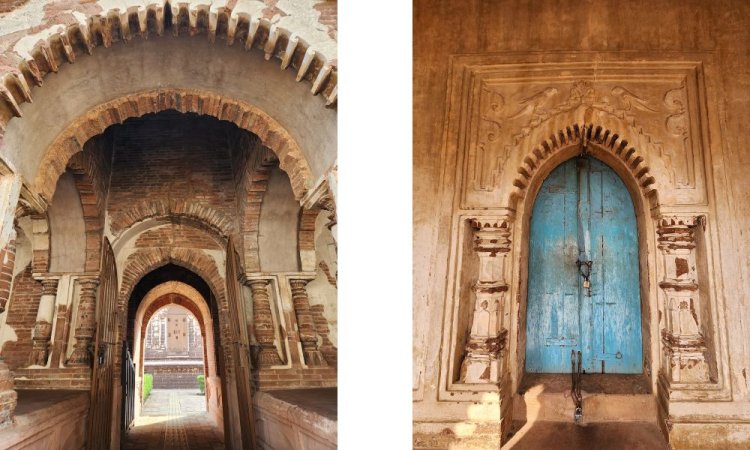 In front of the temple, there is a dancing hall and there is a tower in Orissan style in the west dedicated to Raghunath. The outer yard is divided from the inner by a wall and contains a small Pancharatna temple of Kameswar Siva with an inscription dated 1655 AD. The temple is enclosed by a wall entirely with a gateway passage towards the east. There are two cars in front of the gateway, one for Lord Lalji and the other is for Lord Raghunath which are taken out in procession during Dussehra festival. There are inscriptions in Bengali at several places.
In front of the temple, there is a dancing hall and there is a tower in Orissan style in the west dedicated to Raghunath. The outer yard is divided from the inner by a wall and contains a small Pancharatna temple of Kameswar Siva with an inscription dated 1655 AD. The temple is enclosed by a wall entirely with a gateway passage towards the east. There are two cars in front of the gateway, one for Lord Lalji and the other is for Lord Raghunath which are taken out in procession during Dussehra festival. There are inscriptions in Bengali at several places.
Shyam Rai Temple
The temple was built by King Raghunath Singh in 1643, is popularly known as ‘Panch-chura’ temple as it owns five pinnacles. The temple looks beautiful with triple arched passage on its four sides. It is one of the star attractions of Bishnupur because of its breathtaking terracotta art-forms on both interior and exterior panels. Various scenes based on religious stories like ‘Indra fighting sitting on Oirabot’, ‘Saga of Ram and Raban’,’Glimpses of Krishna Lila’, ‘love of Radha-Krishna’, ‘Hunting scenarios from old society’ etc. are truly representing the terracotta art at its best. Another attraction of this temple is a giant Raschakra that depicts various forms of ‘Radha-Krishna Lila amidst of Gopinis’.
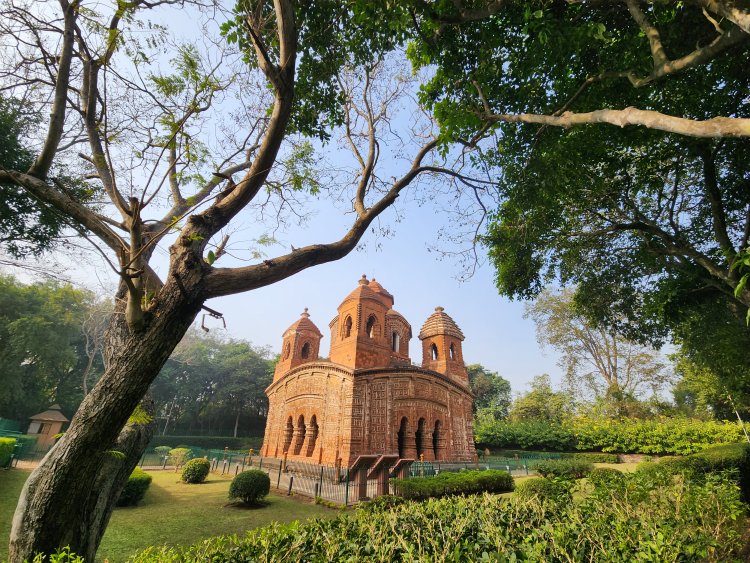
Perhaps the most notable and exceptional feature of the Shyam Rai temple are the circular medallions, the largest pair can be found on the south-facing elevation which is also the main entrance to the temple, but four smaller versions can also be seen on the east-facing elevation. These are Rasa Mandalas, which unfold as a sublime cosmic dance, an exquisite portrayal of Lord Krishna’s divine play. The term “Mandala” denotes the cosmic circle that encapsulates the profound significance of this celestial event. The enchanting episode transpires on a moonlit night in Braj, where the air is saturated with the heady fragrance of jasmine.
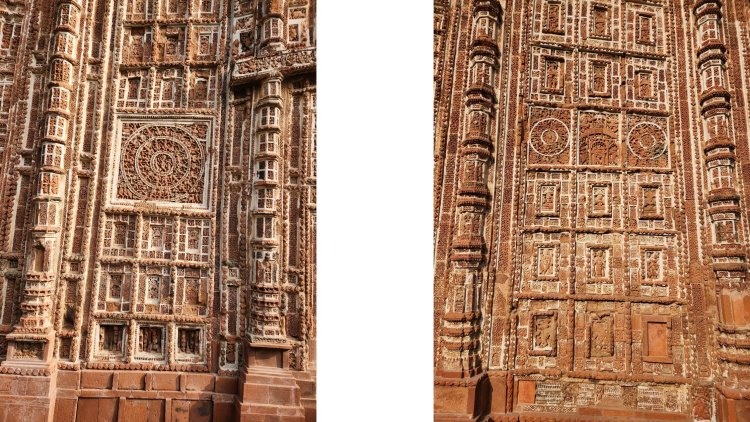
The most notable and exceptional feature of the Shyam Rai temple are the circular medallions found on the outer wall of the temple.The largest circular pair can be found on the south-facing elevation which is also the main entrance to the temple, but four smaller versions can also be seen on the east-facing elevation.
They are Rasa Mandalas, which represent a rhythmic dance, an exquisite portrayal of Lord Krishna’s divine play. The term “Mandala” denoting the cosmic circle signifies a celestial event.
Lord is in absolute elative mood, an epitome of divine bliss.To the tune of his flute described in the Bhagavat Purana, the gopis, in tune to the music an seem lost in estasy.
Madan Mohan Temple
Located 450m west of Radha Binod Temple in the north of Bishnupur, the Madan Mohan Temple was constructed in 1694 by Durjan Singha Dev, the 53rd Malla king and son of Bir Singha Dev. He ruled from 1682 to 1702, and was respected as a gentle, logical, pious and kind hearted king. It was during his reign that several Portuguese, French, and British traders came to Bishnupur, and the town flourished as a result.
Built on a large square laterite plinth, this south-facing eka-ratna temple was erected to enshrine the guardian deity of the Malla Kings.Three arched entrances on three side of the temple open into a corridor which, through another arched gateway, opens into the main sanctum. The entire building, including its roof, is constructed with terracotta brick.
The amount of creativity shown by the architects of that period despite the limitations is quite remarkable, and they did a good job, this temple has stood the vagaries of nature.
On the Outer Wall
The Madan Mohan temple is celebrated for its terracotta ornamentation that covers the south-facing elevation, the other three elevations have been almost entirely left plain. The entire surface of the main facade is covered with beautiful terracotta panels which depict Krishna’s childhood, stories from Ramayana and Mahabarata.
The principal panels above the main entranceway are filled with battle-scenes from the Mahabharata, quite unusual for temples of this period in Bengal which primarily reserve such panels only for the Ramayana.
Unusually for many of the terracotta temples in Bishnupur, this is still a living temple. In the sanctum resides Madan Mohan and Radha- a form of Lord Krishna and one of the incarnations of the Hindu god Vishnu.The door was locked so we were not able to go inside.
Horses of Panchmura
I could see the artifacts along the streets.What made me wonder is the most are the curvy horses the artisans make in the village Panchmura, which is located at a short drive from the town of Bishnupur. Given the kingdom ceased to exist, and not a single living horse in near vicinity, these craftsmen instill life in each of the earthen pieces with care.
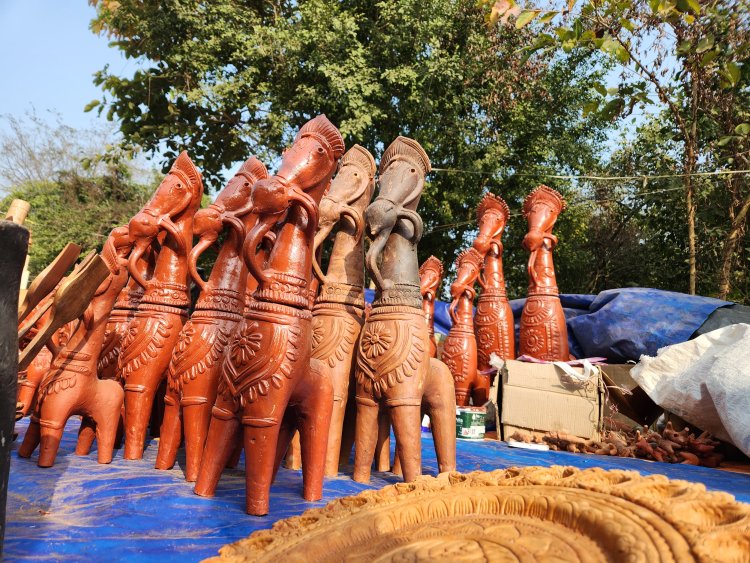
The earthen or wooden horses of the land are well acclaimed in the country and outside. They are undoubtedly cheaper when sourced from Bishnupur. However, without proper emphasis and exposure, many of the artisans are eyeing for alternate work opportunities, threatening the art to die.
The Bankura horses can get even bigger than this!
The elephants and other terracotta artefacts, you pick as a memento to decorate your house.In the meanwhile to support to artisans and art in general !
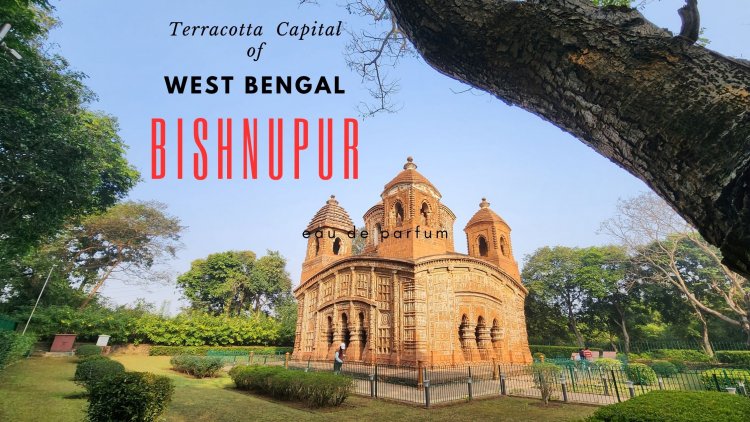
 Experience the oldest Durga Puja of Bengal (1021 years) and rich heritage immersing into a different flavor of religious warmth during the Puja. The festival starts with the worship of “Baro thakurani”, “Mejo thakurani” and “Choto thakurani” respectively, after setting up of a clay pot or “Ghat”. On the sacred moment of “Mahastami- Sandhipuja”, a cannon is fired and then vegetables are sacrificed.
Experience the oldest Durga Puja of Bengal (1021 years) and rich heritage immersing into a different flavor of religious warmth during the Puja. The festival starts with the worship of “Baro thakurani”, “Mejo thakurani” and “Choto thakurani” respectively, after setting up of a clay pot or “Ghat”. On the sacred moment of “Mahastami- Sandhipuja”, a cannon is fired and then vegetables are sacrificed. Constructed over four hundred years ago, between the 17th and 18th century, these temples display diverse styles of unique architecture. Rasmancha, for example, made in the year 1600 AD by king Bir Hambir for the annual ‘ras' festival, looks more like a baradari (pavilion) and less like a temple. The building stands on a high raised platform and is held together in an intricate pattern of thin bricks with indigenous mortar made of lentils, spices, milk, rice husk, etc.
Constructed over four hundred years ago, between the 17th and 18th century, these temples display diverse styles of unique architecture. Rasmancha, for example, made in the year 1600 AD by king Bir Hambir for the annual ‘ras' festival, looks more like a baradari (pavilion) and less like a temple. The building stands on a high raised platform and is held together in an intricate pattern of thin bricks with indigenous mortar made of lentils, spices, milk, rice husk, etc. 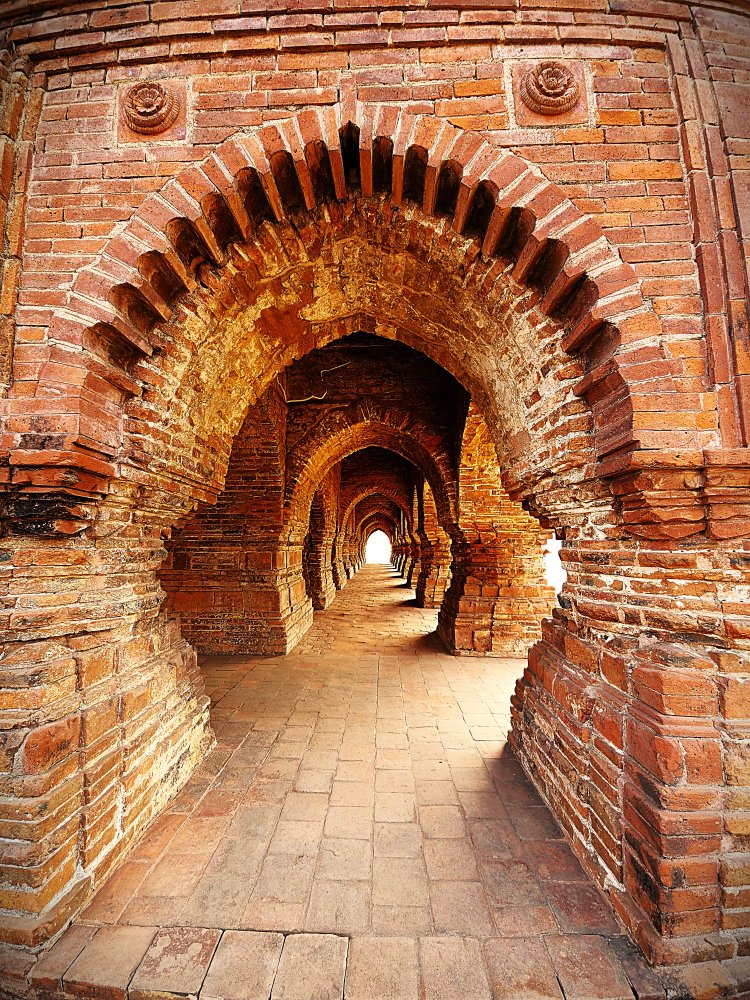
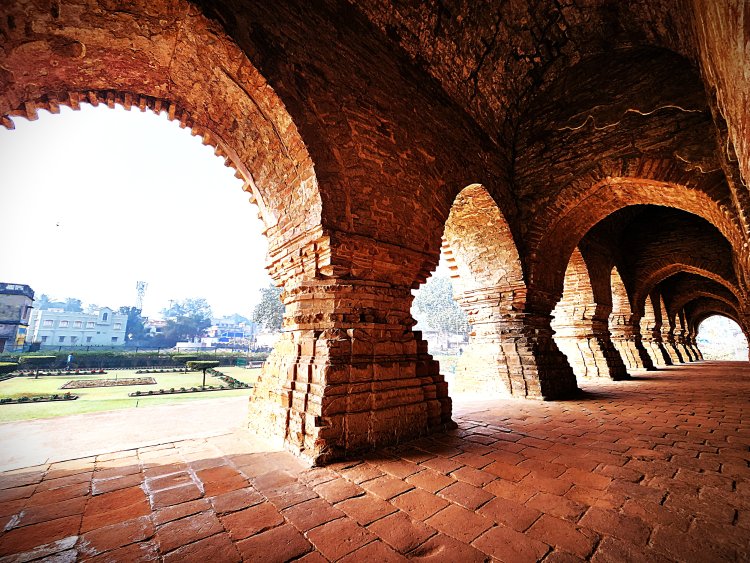


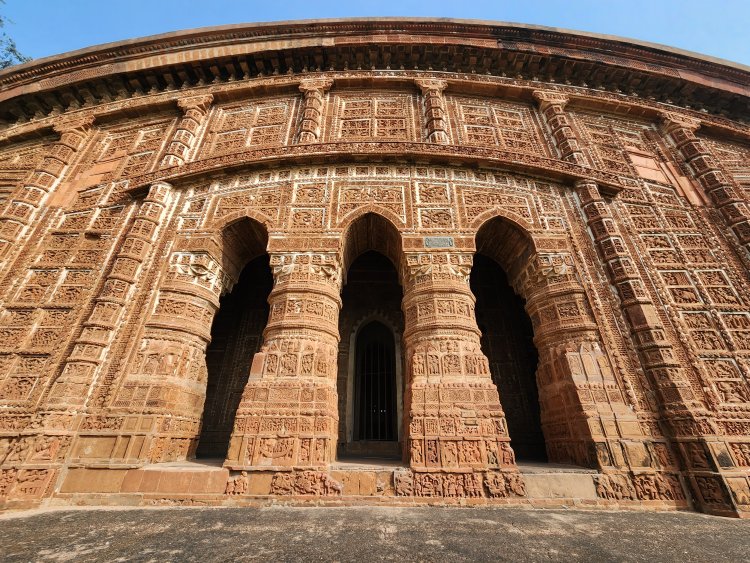
 In front of the temple, there is a dancing hall and there is a tower in Orissan style in the west dedicated to Raghunath. The outer yard is divided from the inner by a wall and contains a small Pancharatna temple of Kameswar Siva with an inscription dated 1655 AD. The temple is enclosed by a wall entirely with a gateway passage towards the east. There are two cars in front of the gateway, one for Lord Lalji and the other is for Lord Raghunath which are taken out in procession during Dussehra festival. There are inscriptions in Bengali at several places.
In front of the temple, there is a dancing hall and there is a tower in Orissan style in the west dedicated to Raghunath. The outer yard is divided from the inner by a wall and contains a small Pancharatna temple of Kameswar Siva with an inscription dated 1655 AD. The temple is enclosed by a wall entirely with a gateway passage towards the east. There are two cars in front of the gateway, one for Lord Lalji and the other is for Lord Raghunath which are taken out in procession during Dussehra festival. There are inscriptions in Bengali at several places.

